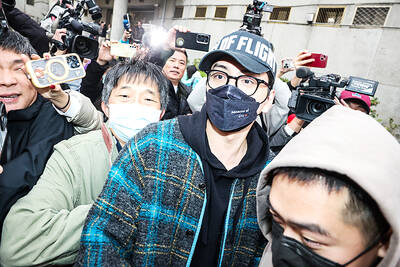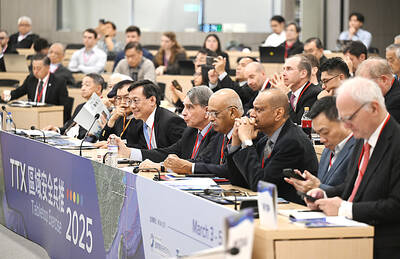Pollutant particles from China may be arriving in Kinmen Island every winter with the northeast seasonal cold front, bringing carcinogenic heavy metals to the traditionally clean outlying island and increasing long-term cancer risks for its residents tenfold, Academia Sinica’s Research Center for Environmental Changes (RCEC) said yesterday.
“Air particulate matter [PM] concentration on the island during the winter months — from September to May — has in recent years been on the rise. Many times a year, PM10 [fine particles in the air smaller than 10 micrometers in size] concentrations reach an alarming 100 or even 150 micrograms per cubic meter,” said RCEC assistant research fellow Hsu Shih-chieh (??, citing statistics collected by the Environmental Protection Administration (EPA).
Hsu said the increase in pollutants in the winter suggested that much of it had been carried to Kinmen from afar by seasonal cold fronts, which do not blow during the summer and fall months.
More alarming is that among the PM10 particles, more than 50 percent are PM2.5 particles, which are more easily inhaled by the human body and therefore cause more damage, he said.
“The WHO advises that a 24-hour average concentration for PM2.5 should not exceed 25μm/m³, or people begin to develop heart, lung and reproductive problems, or even cancer,” Hsu said. “However, the EPA’s data suggests that Kinmen’s PM2.5 concentrations sometimes are more than double the recommended level, at between 50μm/m³ and 75μm/m³.”
Because of the problem, the National Science Council commissioned Hsu’s team to find out what types of pollutants the air particles contain, as well as where they may have come from, Hsu said.
“Since November in 2007, we have been collecting air samples at Kinmen’s Jinning Elementary and Junior High School. We found that the ratio of PM2.5 to PM2.5 to PM10 is 62 to 38 in the winter in Kinmen and the main composition of the particles includes sulfates, nitrates and heavy metals,” he said.
From a match of iron to aluminum ratio between the air samples and air samples in surrounding regions, Hsu’s team also found that the pollutants possibly came from Jinjiang (晉江), a town in China’s Fujian Province known for its pottery industry.
“Besides the resulting powder from pottery manufacturing, because many of the factories burn bad-grade coal in the process, massive amounts of sulfur dioxide and carcinogenic heavy metals — such as arsenic — are emitted,” Hsu said.
With arsenic concentrations at 28 nanograms per cubic meter, RCEC associate research fellow Candice Lung (龍世俊) said: “We were very surprised that Kinmen — a place most people consider unpolluted — would have arsenic concentrations three times that of Taipei.”
With a 70-year long-term exposure to the particles, a person living in Kinmen would have a 10-fold increase in their chances of developing lung cancer, Lung said.
As for the future, both Hsu and Lung said the next step would be to work with academics across the strait to address the situation.
“Pollutants know no borders, this is a regional problem and one that affects the health of people on both sides of the Taiwan Strait,” Hsu said.

Actor Darren Wang (王大陸) was questioned by prosecutors for allegedly orchestrating an attack on a taxi driver after he was allegedly driven on a longer than necessary route in a car he disliked. The questioning at the New Taipei City District Prosecutors’ Office was ongoing as of press time last night. Police have recommended charges of attempted murder. The legally embattled actor — known for his role in the coming-of-age film Our Times (我的少女時代) — is under a separate investigation for allegedly using fake medical documents to evade mandatory military service. According to local media reports, police said Wang earlier last year ordered a

President William Lai (賴清德) should protect Taiwan Semiconductor Manufacturing Co (TSMC), and stop supporting domestic strife and discord, former president Ma Ying-jeou (馬英九) wrote on Facebook yesterday. US President Donald Trump and TSMC on Monday jointly announced that the company would invest an additional US$100 billion over the next few years to expand its semiconductor manufacturing operations in the US. The TSMC plans have promoted concern in Taiwan that it would effectively lead to the chipmaking giant becoming Americanized. The Lai administration lacks tangible policies to address concerns that Taiwan might follow in Ukraine’s footsteps, Ma wrote. Instead, it seems to think it could

A man in Tainan has been cleared on charges of public insult after giving the middle finger during a road rage incident, as judges deemed the gesture was made “briefly to express negative feelings.” In last week’s ruling at the High Court’s Tainan branch, judges acquitted a driver, surnamed Cheng (程), for an incident along Tainan’s Nanmen Road in September 2023, when Cheng had spotted a place to park his car in an adjacent lane. Cheng slowed down his vehicle to go into reverse, to back into the parking spot, but the car behind followed too closely, as its driver thought Cheng

DEFENSE: The purpose of the exercises is to identify strategies for the government to control risks during tensions, prevent war and bolster national resilience A tabletop exercise series has begun simulating possible scenarios if the Chinese People’s Liberation Army (PLA) launched a war against Taiwan in the guise of a military exercise. The exercise series is jointly organized by National Chengchi University’s Institute of International Relations, Taiwan Center for Security Studies and Asia-Pacific Policy Research Association. Chinese Nationalist Party (KMT) Legislator Chen Yeong-kang (陳永康), former American Institute in Taiwan (AIT) director William Stanton and Taiwan Center for Security Studies director Liu Fu-kuo (劉復國) attended the event in Taipei yesterday. Scenarios that would be simulated include changing political circumstances in the US during US President Donald Trump’s tenure